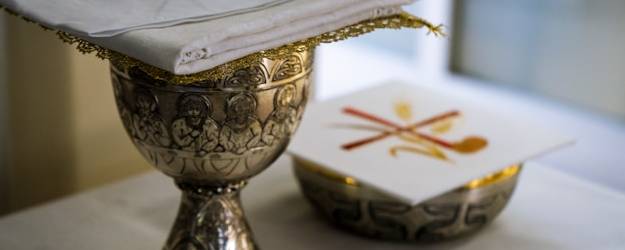By Rev. John P. Cush, STD, consulting with Fr. Timothy Eck
What Can Chalices Be Made Of?
Question: My priest uses a Waterford Crystal Chalice and Paten for the celebration of Holy Mass. Is this permitted according to the 2002 General Instruction of the Roman Missal?
Answer: The 2002 General Instruction of the Roman Missal (GIRM) provides a few instructions relevant to this question. GIRM 328 says, “Sacred vessels should be made from precious metal.” Therefore, the normative material for sacred vessels is precious metal.
In the following paragraph, §329, the GIRM does note, though:
In the Dioceses of the United States of America, sacred vessels may also be made from other solid materials which in the common estimation in each region are considered precious or noble, for example, ebony or other harder woods. . . . In this case, preference is always to be given to materials that do not easily break or deteriorate. This applies to all vessels that are intended to hold the hosts, such as the paten, the ciborium, the pyx, the monstrance, and others of this kind.
This means that sufficiently noble and solid materials could be used in a sacred vessel so long as they do not easily break. Note, however, that the end of the paragraph restricts the scope of this permission to vessels which hold the hosts. It makes no mention of vessels which contain the Precious Blood.
The following paragraph, §330, discusses the chalice, stating, “As regards chalices and other vessels that are intended to serve as receptacles for the Blood of the Lord, they are to have a bowl of material that does not absorb liquids. The base, on the other hand, may be made of other solid and worthy materials.” So one could argue that so long as the bowl does not absorb liquids (which crystal does not) and the material is worthy or noble (which quality crystal-wear is) that it could be used.
The one loose end in all this, though, comes from the need for the material to not easily break in GIRM 329. In 2004 the then-Congregation for Divine Worship and the Discipline of the Sacraments promulgated the Instruction Redemptionis Sacramentum (RS) providing normative clarifications on many practical liturgical considerations. Speaking on this kind of situation, it states, “Reprobated, therefore, is any practice of using for the celebration of Mass . . . vessels made from glass, earthenware, clay, or other materials that break easily.” (RS 117) This clarification then disqualifies Waterford Crystal from being used for a chalice or paten, since no glass vessels are permitted.
What Do Priests’ Vestments Mean?
Question: I have seen my priest wear his stole over his chasuble at Mass recently. I had been told that the stole, which represents authority, was to always be under the chasuble, which represents charity. Is my priest correct in this vesture?
Answer: The stole is worn underneath the chasuble during the celebration of the Mass. The General Instruction of the Roman Missal (GIRM) is clear in this matter: “The vestment proper to the Priest Celebrant at Mass and during other sacred actions directly connected with Mass is the chasuble worn, unless otherwise indicated, over the alb and stole.” (GIRM 337) Though this paragraph refers to a priest, the GIRM uses priest to indicate both bishop and presbyter and notes when something differs between the two. Both bishops and presbyters are bound by this rubric.
Further, the clause, “unless otherwise indicated,” does not indicate that there is a moment when the stole (or alb for that matter) is worn over the chasuble, but when something other than a chasuble (like the cope cf. GIRM 341) is worn by the priest over the alb and stole. There is never a moment when the stole is worn over the outermost garment (chasuble, cope, or dalmatic) in the liturgy.
At a symbolic level, it is also discordant to wear the stole over the chasuble. The stole indicates the authority of the minister by which they fulfill their liturgical office. The chasuble indicates the charity of Christ in which they fulfill the office, and it also symbolizes the yoke of Christ under which they submit in obedience in executing their office. To place the stole over the chasuble would be to assert the minister’s authority over the charity of Christ and their obedience to Christ. It is true that the stole is often unseen, but in a way the authority of the clergy should be unseen but experienced through the love of Christ, which expresses the authority entrusted to the person who acts in humble obedience to the Lord on behalf of the people of God.

Speak Your Mind